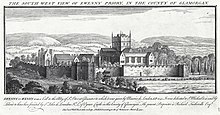Edward Carne
Sir Edward Carne (c. 1500 – 19 January 1561) was a Welsh Renaissance scholar, diplomat and English Member of Parliament.

Life history
[edit]Carne was born around 1500, the second son of Howell Carne[1] of Cowbridge in Glamorgan, and his wife Cicily, the daughter of William Kemys. Carne was descended from Thomas Le Carne, who was the second son of Ithyn, King of Gwent. He was educated at Oxford University, and became principal of Greek Hall. He was made Doctor of Civil Law in 1524.
His wife was Anne, a daughter of Sir Edward Mansel of Margam.[2][3] He had one legitimate son, William,[2] and four daughters.
Carne became known as an erudite and eloquent speaker and became attached to the court of Henry VIII. In 1530 he was selected in a legal capacity to represent the embassy of the Earl of Wiltshire, Anne Boleyn's father.
Carne profited from the Dissolution of the Monasteries in Glamorgan, where he purchased Ewenny Priory, building a house there after 1545.[4] In 1539 he obtained the lease of Gaunt's Hospital, Bristol, and acted as its treasurer.[5] He was due to go abroad to arrange the ill-fated marriage of Anne of Cleves to King Henry VIII, and the revenue from the foundation was directed in the meantime to the support of his wife, Anne Denys, a daughter of Sir William Denys (d.1535) of Dyrham, Glos.[6] Bristol Corporation objected, and in 1540 the church was purchased by Bristol Corporation.[7]
He was appointed High Sheriff of Glamorgan for 1543 and 1554, Master of Requests from 1540 to 1554 and was elected knight of the shire (MP) for Glamorgan in 1554.[8]
During Queen Mary's reign he served on embassies to Emperor Charles V and to Rome, where he chose to remain on the accession of Elizabeth I and was put in charge of the English hospital of St. Thomas in the city. He is buried in the narthex of the Church of St. Gregory on the Caelian Hill in Rome.
References
[edit]- ^ Lewis Morris; Cambrian Archaeological Association (1878). Celtic Remains. J. Parker. pp. 189.
- ^ a b Thomas Nicholas (1872). Annals and Antiquities of the Counties and County Families of Wales: Containing a Record of All Ranks of the Gentry ... with Many Ancient Pedigrees and Memorials of Old and Extinct Families. Longmans, Green, Reader. p. 624.
- ^ John Burke; Sir Bernard Burke (1844). A Genealogical and Heraldic History of the Extinct and Dormant Baronetcies of England, Ireland, and Scotland. J. R. Smith. p. 339.
- ^ "Ewenny Priory (house)". British Listed Buildings. Retrieved 4 September 2017.
- ^ Bristol & Gloucestershire Archaeological Society (BGAS) Transactions 1878/9, vol. 3, pp.245-6
- ^ Bindoff S.T. History of Parliament: House of Commons 1509-1558, vol. 1, Carne, E., p.586
- ^ Jones, Donald (2000). Bristol Past. Chichester: Phillimore. pp. 30–32. ISBN 1-86077-138-6.
- ^ "CARNE, Sir Edward (1495/96–1561)". History of Parliament Online. Retrieved 30 August 2011.
- C. J. O. Evans (1938), Glamorgan, its History and Topography
External links
[edit]- . Dictionary of National Biography. London: Smith, Elder & Co. 1885–1900.
- 1500 births
- 1561 deaths
- Welsh diplomats
- People associated with the Dissolution of the Monasteries
- People from Cowbridge
- English MPs 1554–1555
- Alumni of the University of Oxford
- 16th-century Welsh politicians
- High sheriffs of Glamorgan
- 16th-century English diplomats
- Members of the Parliament of England for Glamorganshire
- Ambassadors of England to the Holy See
